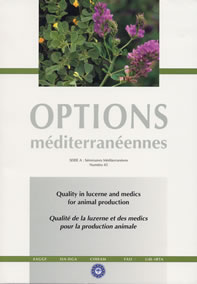| Article précédent | p. 111-114 | Article suivant |
Ten years of ecological research on Medicago minima (L.) Bart.
Medicago minima (L.) Bart. is one of the most widely distributed annual medics in both the Mediterranean basin and other semiarid temperate regions. This pasture legume is widely naturalised in Argentina and Australia and this paper discusses a series of ecological studies carried out between 1988-1999. Geographic distribution, morphology and phenology, seed dormancy, germination, seedling emergence and survival, responses to water stress and pasture production are addressed. Genetic variation is discussed in relation to the ability of the species to grow and cope with stresses encountered in a wide range of environments. These findings help explain why M. minima is so widespread and why it is a successful colonising species. A better knowledge of its ecophysiology has contributed to gain an understanding of the adaptative strategies of this species and to develop guidelines for its proper management in extensive production systems.
- [ Afficher ]
- [ Télécharger ]
- [ Exporter la citation ]
Vous pouvez télécharger la citation au format :
- [ Imprimer ]
-
Mots-clés
ADAPTATION, DISTRIBUTION GEOGRAPHIQUE, MEDICAGO, VARIATION GENETIQUECiter cet article
Fresnillo D.E. Ten years of ecological research on Medicago minima (L.) Bart.. In : Delgado I. (ed.), Lloveras J. (ed.). Quality in lucerne and medics for animal production . Zaragoza : CIHEAM, 2001. p. 111-114. (Options Méditerranéennes : Série A. Séminaires Méditerranéens; n. 45). 14. Réunion Eucarpia du Groupe Medicago spp., 2001/09/12-15, Zaragoza and Lleida (Spain). http://om.ciheam.org/om/pdf/a45/01600068.pdf



